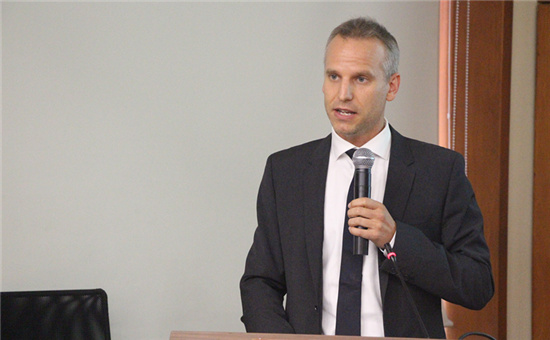Survey: China Carbon Emissions Expected to Peak Ahead of 2030
chinagate.cn, September 9, 2015 Adjust font size:

Dimitri de Boer, Vice Chairman of China Carbon Forum [Jiao Kai / Chinagate.cn]
A survey of China-based experts and businesses gives strong confidence that carbon price levels in China will rise over time, and that carbon pricing will increasingly affect investment decisions. Over 80% of the survey respondents expect that China will meet its target to peak emissions by 2030, and many expect that the peak will be reached significantly sooner.
The 2015 China Carbon Pricing Survey was conducted by China Carbon Forum (CCF), an independent Beijing-based non-profit, and climate change consultancy ICF International. It collected over 300 responses from stakeholders in China’s emerging carbon market.
The Chinese government has announced that a national emissions trading scheme (ETS) will be established in early 2017, although many of the survey respondents expect that it could take until 2020 or so before the national ETS will be fully functional across mainland China. Prices in the national ETS are expected to steadily rise from about 40 RMB per tonne of CO2 emitted in 2017, to about 70 RMB/t in 2025.
Mr. Wang Shu, an official of the National Development and Reform Commission’s Climate Change Department: “China is quickly gaining experience with carbon trading through the seven ETS pilots, and is making all efforts to establish a national ETS by 2017. According to the survey by China Carbon Forum, it is expected that the cost of emitting carbon will rise over time. The policy framework of China’s carbon market should factor in this rising future carbon price, and establish appropriate market regulation mechanisms, while actively enhancing capacity of market participants based on their actual needs, so as to maintain a healthy and stable development of the carbon market.”
Dr. Zou Ji, deputy director of the National Center for Climate Change Strategy and International Cooperation (NCSC), a government-affiliated think-tank: “The Chinese government is moving towards market-based methods for environmental protection and to mitigate climate change. This survey is enlightening as it quantifies the positions and expectations of the market participants.”
Dimitri de Boer, Vice Chairman of China Carbon Forum and a co-author of the study believes its results will bolster confidence in China’s climate action: “As governments around the world are preparing for the climate conference in Paris in November, they are carefully looking at China and its efforts to mitigate greenhouse gas emissions. This survey gives strong confidence that China will meet and exceed its targets.”
China currently operates seven pilot emissions trading schemes, in which prices have been depressed in recent months due to over-allocation of allowances. It is expected that their prices will quickly rebound, reaching 33 to 55 RMB by the end of 2016.
The survey suggests that in the coming years until 2025, China’s mix of policy instruments to control carbon emissions will markedly shift towards carbon trading, tax, and information disclosure. Although most respondents expect that a carbon tax will eventually be introduced, there remains much uncertainty over its timing.